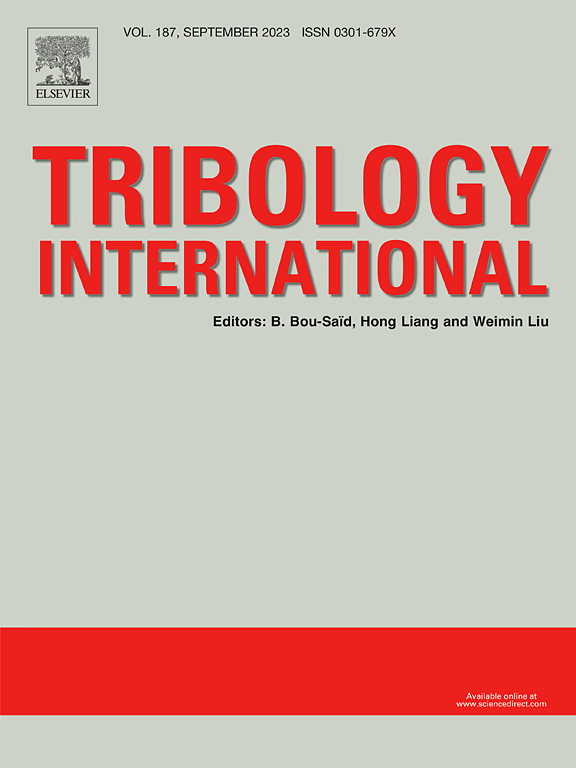Tribological properties of graphene oxide reinforced aramid paper-based composites
IF 6.1
1区 工程技术
Q1 ENGINEERING, MECHANICAL
引用次数: 0
Abstract
Self-lubricating paper-based composites can provide technological solutions such as low friction and extended service life for the aerospace airframe kinematic mechanical components. To improve the tribological properties of aramid short fibers, this study chemically combined graphene oxide (GO) with aramid nanofibers (ANF) through intermolecular forces, creating a self-lubricating GO-reinforced aramid paper-based composite GO/ANF. Mechanical performance tests have shown that the introduction of GO can significantly improve the fracture strength, Young's modulus, and toughness of paper-based composites. The frictional performance test results show that compared with ANF, the GO/ANF paper-based composites can maintain the lowest coefficient of friction (COF) and wear under high load and high sliding rate conditions. When the amount of GO added is 1 wt%, the COF and volume wear rate of GO/ANF paper-based composites are reduced by 23 % and 89 %, respectively. Mechanism analysis indicates that synergistic effects and friction transfer films are important factors contributing to the excellent performance of paper-based composites. This GO/ANF paper-based composite has good application prospects as a good anti-wear liner material in self-lubricating sliding bearing.
氧化石墨烯增强芳纶纸基复合材料的摩擦学特性
自润滑纸基复合材料可为航空机身运动机械部件提供低摩擦和延长使用寿命等技术解决方案。为改善芳纶短纤维的摩擦学性能,本研究通过分子间作用力将氧化石墨烯(GO)与芳纶纳米纤维(ANF)化学结合,形成了自润滑GO增强芳纶纸基复合材料GO/ANF。机械性能测试表明,GO 的引入可以显著提高纸基复合材料的断裂强度、杨氏模量和韧性。摩擦性能测试结果表明,与 ANF 相比,GO/ANF 纸基复合材料能在高负载和高滑动率条件下保持最低的摩擦系数(COF)和磨损。当 GO 的添加量为 1 wt% 时,GO/ANF 纸基复合材料的 COF 和体积磨损率分别降低了 23% 和 89%。机理分析表明,协同效应和摩擦传递膜是纸基复合材料具有优异性能的重要因素。这种 GO/ANF 纸基复合材料作为自润滑滑动轴承的良好抗磨衬垫材料具有良好的应用前景。
本文章由计算机程序翻译,如有差异,请以英文原文为准。
求助全文
约1分钟内获得全文
求助全文
来源期刊

Tribology International
工程技术-工程:机械
CiteScore
10.10
自引率
16.10%
发文量
627
审稿时长
35 days
期刊介绍:
Tribology is the science of rubbing surfaces and contributes to every facet of our everyday life, from live cell friction to engine lubrication and seismology. As such tribology is truly multidisciplinary and this extraordinary breadth of scientific interest is reflected in the scope of Tribology International.
Tribology International seeks to publish original research papers of the highest scientific quality to provide an archival resource for scientists from all backgrounds. Written contributions are invited reporting experimental and modelling studies both in established areas of tribology and emerging fields. Scientific topics include the physics or chemistry of tribo-surfaces, bio-tribology, surface engineering and materials, contact mechanics, nano-tribology, lubricants and hydrodynamic lubrication.
 求助内容:
求助内容: 应助结果提醒方式:
应助结果提醒方式:


